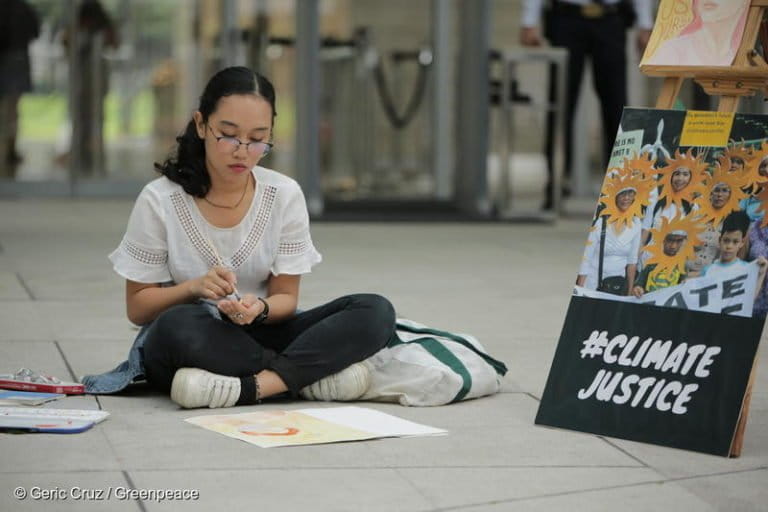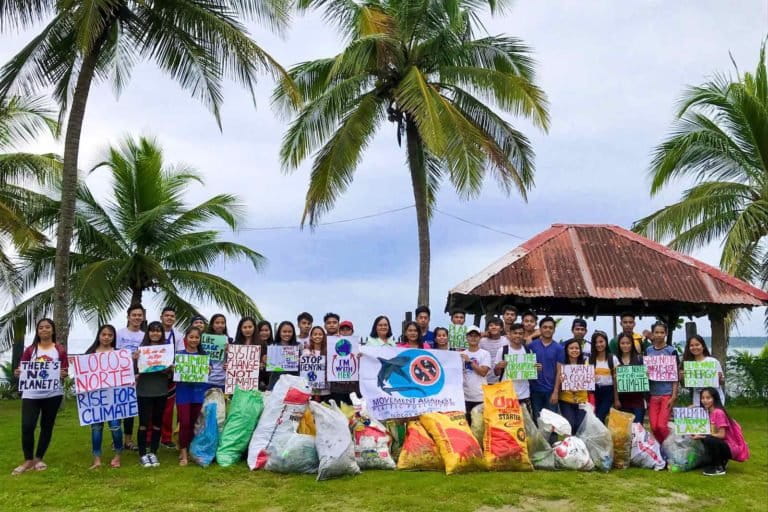- When Super-Hurricane Haiyan descended on the Philippines in 2013, it not only left behind more than 7,400 casualties and nearly $5 billion in destruction. It also helped birth a strong youth climate justice movement.
- That movement is now surging across Southeast Asia, with major climate strikes by students in the Philippines, Malaysia, Indonesia, Myanmar, Thailand and Cambodia on September 20.
- Such acts of defiance are not easy in Asia, where deference and obedience to parents and elders is deeply ingrained. But with the whole world at risk, Asia’s young people are in the streets and determined to save the future for their nations and themselves.

MANILA, the Philippines – In 2013, Marinel Ubaldo was just 16 years old and Matarinaw, her seaside village in Eastern Samar, was paradise. She considered herself a simple barrio lass who found contentment in collecting seashells for decorative uses and sea cucumbers for dinner. Sometimes, she went out onto the Pacific Ocean along with his father, a local fisherman. Life was simple, quiet, happy.
She was aware, yet blissfully ignorant, of climate change.
In that same year, Super-Hurricane Haiyan descended on the Philippines. It arrived on November 3 and left eight days later leaving behind at least 7,417 casualties, more than a thousand people missing and $4.9 billion in damages. The storm placed seven provinces under a state of disaster and caused a humanitarian crisis. The most ravaged areas were Samar and Leyte, where 90 percent of infrastructures and homes were flattened to the ground.
Local and provincial governments assumed that Matarinaw had been blotted off the map, and with mountain boulders covering access roads, no help arrived. In the weeks that followed, Ubaldo and her family lived in forlorn hope on stray cans of sardines that washed ashore. She remembers the once blue sea of her childhood littered with corpses and the air reeking of rotting flesh. Whenever the winds growled, she shivered and cried. The slightest rainfall today has the same impact, making her uneasy.
Yet Ubaldo carried inside her determination unusual in someone so young. “Haiyan changed my life and changed me,” she tells Mongabay. “I was forced to grow up. I felt helpless but I know I have to survive.”

Dedication to the climate crisis
Within a year, Ubaldo was devoting her time to learning more about climate change and its impacts – and what she could do on the ground as a social worker. Now age 22, she organized the Philippines first youth climate strike last May in Tacloban and with the same fervor, led the climate mobilization on September 20, 2019.
“Climate justice has become my advocacy. It’s imbued in my heart, body and spirit,” she says. “I know I can change this reactive response to disasters and if policymakers are really concerned for our welfare, then they should listen.”
The protest in Tacloban is part of Youth 4 Climate Philippines, a nationwide youth-led series of strikes buoyed by a shared love for the environment, and a common fear of climate change. It is part of the Global Climate Strike movement, which in turn was inspired by Swedish teen activist Greta Thunberg. She will be leading a major student protest on September 23rd as the United Nations meets for its Climate Action Summit – an event where the world’s nations are supposed to increase their 2015 Paris Climate Agreement carbon reduction pledges.
“Climate Change strikes hard, but the YOUTH will strike harder!” goes the group’s catchphrase “Let’s step up for the planet!” says another. The momentum, ignited by Thunberg’s original lone protest back home in Europe, has engaged Philippine youths in 28 locations to do the same: skip school to hold rallies, workshops and talks from September 20, and through the UN declared “Climate Week,” September 27.

A personal battle for a global cause
The Philippines is one of the world’s most vulnerable countries to climate change, and Ubaldo is among the thousands of youth who have experienced the catastrophic impacts first-hand. Their stories of survival have fueled staunch advocacy, imbued with the will to assure they never experience those horrors again.
What frequently bogged them down at first was their strategy: How and where could they most effectively voice their advocacy? But after global calls for youth protest, they found many kindred spirits through Facebook. Since March 14, their page has received more than 5,000 likes and follows and resulted in the creation of sister pages.
Their protests have also received blessings from adults, including education departments and some school heads. On September 17, the national education department issued a memorandum addressed to regional directors, school division superintendents and public and private school heads requesting that schools “excuse students who will be joining the localized climate strike provided that parental/legal guardian consent is given.”
The Philippine Youth for Climate protests are anchored on six major demands: that the government declare a climate emergency; that the nation phase out coal and other fossil fuels in the energy supply chain; that it make a speedy transition to renewables that secure jobs and livelihoods; that it safeguard the rights of indigenous peoples and environment defenders; that it strengthen the country’s adaptation and resilience strategies; and that the Philippines government offer support for local climate solutions.
These sweeping demands have fostered all manner of creative individual expression of protest among young participants. Krishna Ariola, 22, for example, used her skills as a watercolor artist as a means of demonstrating, and painted scenes of fellow youth in dissent against multinational company Shell, an oil and gas superpower.
“I brought along my fellow youth advocates from Negros, using my hands [to relay] their messages!” she says, pointing to the faces in her artwork. “I’m not the only one with this message for Shell. We have had major wins fighting fossil fuels in Negros but that will amount to nothing if the bigger problem is not solved and that is … that major corporations like Shell should face the people and use their resources to mitigate climate change.”
A vegetarian for 16 years, Ariola was raised in a family that was conscious of its carbon footprint. After college, she drew inspiration from “a circle of young, feisty … advocates,” and together they followed the activist path seeking climate justice.
Acting now is important, says Ariola, as climate change will negatively impact the future of today’s youth. “We are young, we have dreams. Our parents did not nurture and send us to school for us to just protest every day,” she says. “But at this point, we don’t have a choice – what’s the point of studying and working hard if we die because of one typhoon?”
Taking to the streets, however, poses high security risks in Negros, a fact of which Ariola and her group are aware. The island of Negros, in the major island group of Visayas, is a hotbed of civilian and activist killings – with 87 recorded deaths as of July. Seven military infantry battalions and 300 police forces are stationed on the island to quell public dissent.
Ariola’s group is cautious but unstoppable. “We are careful because we are a youth group. But many sectors, including civil groups and the Church, are making sure that the youth’s voice is heard. Even if we want to rally and we can, we are looking out for the safety of our friends,” she says.

Stand up, Southeast Asia!
The Philippines isn’t alone. The tide of youth revolution has reached the shores of other Southeast Asian countries. Climate strikes were initiated by female climate justice advocates and occurred on September 20 in Malaysia, Indonesia, Myanmar, Thailand, and Cambodia.
The demonstrations, says organizer and Mongabay intern Nanticha Ocharoenchai, were a risk in themselves, as Asian cultures consider rallies to be “disrespectful to the elderly,” with parents and other elders often viewing such actions as unbecoming or even violent.
“We get a lot of support from students in international schools, but not so much from Thai schools,” the 22-year-old communications graduate says. “Going to rallies is not a nice image. Students are not supposed to stand up… There’s a collective culture that values the hierarchy of seniority.”
Ubaldo agrees: “As children, we’re always told that when older people are talking, we shouldn’t butt in. We have to be quiet and we just let them talk.”
The Asian climate protests pose real risks for young people. For example, Thai schools conduct major annual examinations and some youth activists who attended May demonstrations were at risk of being suspended, which could affect their futures. But despite the risk, many volunteers are willing to join the dissent and add their voices to the fight.
“If there’s no strike at all, that means that no one is demanding anything,” Ocharoenchai says. “At least [with the strike] Thailand has a representation. With this, we are creating awareness. We can do collective impact but in the end, it’s the government who would be responsible.”
The youth activists Mongabay spoke with say that climate justice is at a tipping point in their regions, and they are hopeful that their voices, backed by collective mobilization, could make policymakers listen.
Making the protests positive, rather than focusing on negativity, is thought to be a potential key to success. “Sometimes when we talk about climate change, there’s a lot of negativities,” Ocharoenchai says. “[I ask myself] Does what you do really matter? Will it really save us?”
She found her answer while trekking in a Khao Luang National Park in Sukhothai last year. Surrounded by the verdant tree canopy which she adores, and viewing breathtaking expanses of mountain and sky, Ocharoenchai understood her mission: “Even if this is the last [natural place] left on earth, it’s worth protecting. It’s too beautiful and too precious to give up and I’m sure there’s more places like that on earth,” she concludes.
For Ubaldo the motivation is different. “One day my nieces and nephews will get older and I will have children. When I tell them about climate change, I want … to narrate a story of how we [the youth] fought,” she says. “We stood up against it. We acted, we spoke up, we fought.”
As heads of state, policymakers and stakeholders convene at the United Nations Climate Action Summit tomorrow, the youth of the world will be watching and they will be acting.
Banner image caption: Climate strike in Manilla, the Philippines. Image by Climate Strike Manilla.
This story is part of Covering Climate Now, a global collaboration of more than 300 news outlets worldwide to strengthen coverage of the climate story.
FEEDBACK: Use this form to send a message to the author of this post. If you want to post a public comment, you can do that at the bottom of the page.













